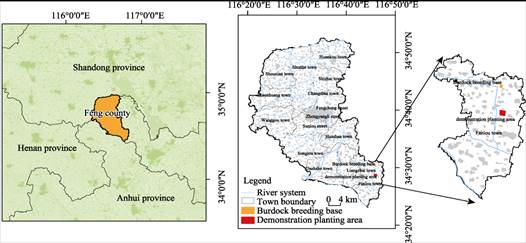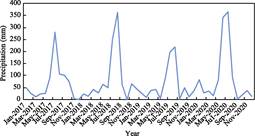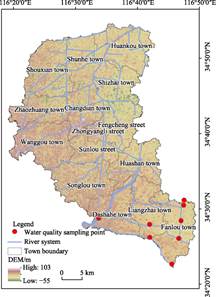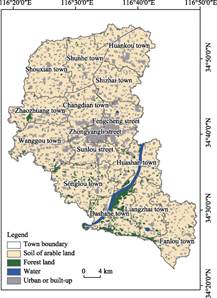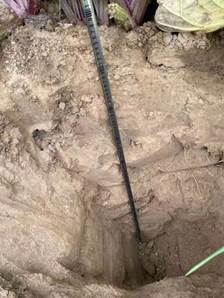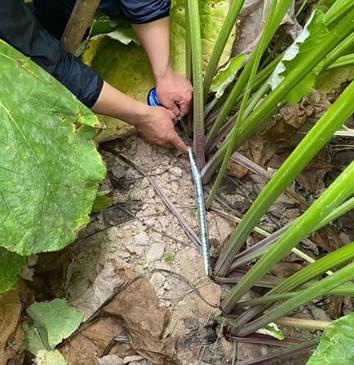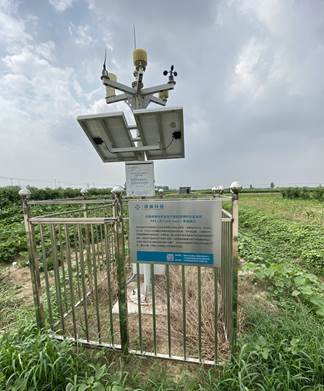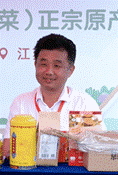Feng County Burdock of the Ancient Yellow River Floodplain
Abstract
The GIES case study on Feng county burdock of the ancient Yellow River floodplain is located in Feng county, Jiangsu province, situated in the Yellow River alluvial flood area on the Huang-Huai Plain, with an altitude of 39 m. It lies in the warm temperate semi-humid monsoon climate zone with distinct seasons, abundant sunshine, and an average annual temperature of around 15 °C. The fertile land with a deep soil layer is highly suitable for the growth of burdock. Burdock, a biennial herbaceous plant of the Asteraceae family, produces seeds known as burdock fruit, traditionally used in Chinese medicine, with its fleshy roots being both edible and medicinal. Feng county is renowned as the “Hometown of Burdock”. As the country’s largest base for burdock cultivation and processing, the production accounts for over 50% of China’s total output, with exports to countries like Japan and South Korea. This case study adopts a scientific approach to summarize the model for ecological environment protection and sustainable development in the ancient Yellow River flood area where burdock is grown. The case study’s dataset consists of five data files including case scope, natural geographic data, burdock characteristics data, management data, and data on natural features and historical and cultural traditions. The dataset is stored in .shp, .tif, .xlsx, and .xls formats, comprising 117 data files with a total size of 367 MB (compressed into one file of 354 MB).
Introduction
Feng county is situated in the northwestern part of Jiangsu province of China, located at the junction of Jiangsu, Anhui, and Shandong provinces (Figure 1), and is renowned as the birthplace of Emperor Gaozu of Han, Liu Bang. Most of the region in Feng county consists of an alluvial plain formed by repeated river breaches and flooding of the ancient Yellow River, with an elevation of 39 m. Feng county falls within a warm temperate semi-humid monsoon climate area, featuring four distinct seasons, abundant sunshine, an average annual temperature of about 15 ℃, and nearly 630.4 mm of annual precipitation. There are over two hundred frost-free days each year. The sandy soil and well-ventilated air in this area create an excellent environment for the growth of root and tuber vegetables[1, 2]. Burdock is a biennial herbaceous plant of the Asteraceae family; its seeds, known as burdock fruit, are traditionally used as a common herbal medicine, and its fleshy root can be used both for food and medicinal purposes. Feng county is celebrated as the “Hometown of Burdock”. The case study area, Fanlou town in Feng county, is located in the Yellow River floodplain region, with a history of cultivating deep-rooted crops such as burdock.
One of the featured products is the dual-purpose burdock, which can be used both as food and medicine. In 2013, burdock from Feng county was listed as a National Geographical Indication Product (Figure 2). The Fengxian Burdock GI covers seven towns of Feng county including Fanlou Liangzhai Huashan Zhaozhuang Wanggou Songlou Dashahe towns.However the case area only cover the area of Fanlou town and the Burdock Breeding Base in Feng county.
Metadata of the Dataset
The metadata of the Fengxian burdock (Arctium lappa) ancient Yellow River flooding area case dataset[4] is summarized in Table 1.
Table 1 Metadata summary of the Feng county’s burdock dataset
| Item | Description | |||
|---|---|---|---|---|
| Dataset full name | Fengxian burdock (Arctium lappa) ancient Yellow River flooding area case dataset on habitat protection and sustainable development | |||
| Dataset short name | FengxianBurdockCase04 | |||
| Authors | Yao, F. T., Jiangsu Academy of Agricultural Sciences, 394866267@qq.com Chang, J. B., Feng County Agriculture and Rural Affairs Bureau of Xuzhou City, Jiangsu Province, xw8532@163.com Zhao, C. Y., Burdock Breeding Base of Feng County, Xuzhou City, Jiangsu Province Hu, C. Y., Feng County Agriculture and Rural Affairs Bureau of Xuzhou City, Jiangsu Province, 542496277@qq.com Wang, Z. B., Institute of Geographic Sciences and Natural Resources Research, Chinese Academy of Sciences,wangzb@igsnrr.ac.cn Wang, Z. X., Institute of Geographic Sciences and Natural Resources Research, Chinese Academy of Sciences, wangzx@igsnrr.ac.cn Li, K. X., Institute of Geographic Sciences and Natural Resources Research, Chinese Academy of Sciences, likx@igsnrr.ac.cn Yu, B. H., Institute of Geographic Sciences and Natural Resources Research, Chinese Academy of Sciences, yubh@igsnrr.ac.cn Chen, W. B., Nature & Science Consulting Co., Ltd. Doke, T., Nature & Science Consulting Co., Ltd. Liu, C., Institute of Geographic Sciences and Natural Resources Research, Chinese Academy of Sciences,lchuang@igsnrr.ac.cn | |||
| Geographical area | Feng county, Xuzhou city, Jiangsu province, | |||
| Data format | .shp, .tif, .xlsx, .docx, .jpg Data size 367 MB | |||
| Dataset files | 4 subdataset (case range data; natural geographic data: land use, hydrology, slope, etc.; management data: burdock cultivation management, burdock harvest processing technology management, traceability technology of Feng county burdock, product business management and operation plans, etc.; Natural features and historical culture: recipes using burdock as an ingredient, etc.) | |||
| Data publisher | Global Change Research Data Publishing & Repository, http://www.geodoi.ac.cn | |||
| Address | No. 11A, Datun Road, Chaoyang District, Beijing 100101, China | |||
| Publication and sharing service platform | Global Change Science Data Publishing System, http://www.geodoi.ac.cn | |||
| Address | No. Jia 11, Datun Road, Chaoyang District, Beijing 100101 | |||
| Data sharing policy | Data from the Global Change Research Data Publishing & Repository includes metadata, datasets (in the Digital Journal of Global Change Data Repository), and publications (in the Journal of Global Change Data & Discovery). Data sharing policy includes: (1) Data are openly available and can be free downloaded via the Internet; (2) End users are encouraged to use Data subject to citation; (3) Users, who are by definition also value-added service providers, are welcome to redistribute Data subject to written permission from the GCdataPR Editorial Office and the issuance of a Data redistribution license; and (4) If Data are used to compile new datasets, the ‘ten per cent principal’ should be followed such that Data records utilized should not surpass 10% of the new dataset contents, while sources should be clearly noted in suitable places in the new datasnew dataset contents, while sources should be clearly noted in suitable places in the new dataset[5] | |||
| Communication and searchable system | DOI, CSTR, Crossref, DCI, CSCD, CNKI, SciEngine, WDS/ISC, GEOSS | |||
DOI: https://doi.org/10.3974/geodp.2023.02.01
CSTR: https://cstr.escience.org.cn/CSTR:20146.14.2023.02.01
Dataset Availability Statement:
The dataset supporting this paper was published and is accessible through the Digital Journal of Global Change Data Repository at: https://doi.org/10.3974/geodb.2021.06.06.V1 or https://cstr.escience.org.cn/CSTR:20146.11.2021.06.06.V1
Case Data Development
Development of Case Area’s Physical Geographic Data and Product Habitat Data
The Case Area
Feng county is located at the confluence of seven counties across four provinces: Jiangsu, Shandong, Henan, and Anhui, and is situated between longitudes 116°21′15″E to 116°52′03″E and latitudes 34°24′25″N to 34°56′27″N. It lies in the central zone of the Huaihai Economic Region. To the north, it borders Jinxiang and Yutai counties of Shandong province; to the south, it is adjacent to Dangshan and Xiao counties of Anhui province; to the west, it connects with Shan county of Shandong province, and to the east, it is linked with Tongshan and Pei counties of Jiangsu province. The regional area covers 1,450.2 km2. Historically, Feng county was part of the ancient Yellow River floodplain. Table 2 compiles historical records from Feng county annals and significant breaches of the Yellow River. From these historical records, it is evident that the major disasters caused by the multiple breaches of the ancient Yellow River had a profound impact on the ecological environment and social development of the region, which is relatively deep and rare in the history of world geographical development.
Table 2 Statistics of historical records of major flooding caused by the Yellow River breaches in Feng county
| Dynasty | Year | Breach location | Disaster details | ||
|---|---|---|---|---|---|
| Jin | Yuanxi 2nd Year (420), June | The Yellow River broke through Henan’s Huazhou and merged with the Qing River in Xuzhou Substantial flooding along the way | the county was severely affected by the Yellow River disaster | ||
| Tang | Dazhong 12th Year (858) | Xuzhou was flooded to a depth of 16 m, tens of thousands of households were washed away; the county suffered major flooding | |||
| Northern Song | Taiping Xingguo 8th Year (983) , May | The Yellow River breached in Huazhou | The county suffered major flooding | ||
| Tianxi 3rd Year (1019), June | The Yellow River breached in Huazhou | The county suffered major flooding | |||
| Xining 10th Year (1077), July | The Yellow River breached in Chanzhou | Prior to this, a Yellow River tributary was over 250 km away from the county; afterwards, the tributary shifted south, reaching the county | |||
| Southern Song | Shaoxing 31st Year (also Jin dynasty Dading 1st Year, 1161), May | The Yellow River breached in Caozhou | The county suffered major flooding | ||
| Yuan | Zhizheng 4th Year (1344) | The Yellow River breached at the Baimaoti | The county suffered major flooding | ||
| Ming | Jiajing 5th Year (1526), June 27th | The Yellow River inundated the county town | |||
| Jiajing 44th Year (1565) | The Yellow River flooded the county territory | ||||
| Wanli 4th Year (1576), August | The Yellow River re-broke through the Taihang dyke for several li | The county territory was flooded | |||
| Wanli 32nd Year (1604), August | The Yellow River breached Zhuwangkou and several places in the Taihang dyke | The county became a vast ocean, houses were submerged for three years, and land prices plummeted | |||
| Chongzhen 4th Year (1631), September | The Yellow River breached at Xinyangmiao and Shiqili Shop | The county territory was flooded | |||
| Chongzhen 9th Year (1636), March | The Yellow River breached | The Yellow River water flooded the county territory | |||
| Qing | Shunzhi 3rd Year (1646) | The Yellow River breached at Liutongkou | Water flowed north into the county | ||
| 4th Year (1647), September 16th | The Yellow River flooded | The excess water entered Feng County from Shan County, poured into the Taihang dyke river, and reached depths of more than 3.3 m | |||
| 5th Year (1648) | The Yellow River flooded | The Yellow River water reached the county town dyke | |||
| Qianlong 58th Year (1793), Spring | The Yellow River flooded | The county territory | |||
| Jiaqing 1st Year (1796) | The Yellow River breached at Pangjialin in Dangshan | The flood entered the county, with large waters surrounding the south, north, and west of the county | |||
| Xianfeng 1st Year (1851), August 19th | The Yellow River breached at Panlongji in Dangshan | The east, south, and north sides of the county were a vast ocean | |||
| 7th-9th Year (1857–1859) | The abandoned Yellow River breached at Panlongji | The flood lasted for three years, causing disaster annually | |||
| Guangxu 1st Year (1875) | The Yellow River breached at Houjialin in Yuncheng county, Shandong | It flowed southeast into the northern part of the county, causing widespread disaster | |||
| Republic of China | Republic Year 1–37 (1912–1948) | The abandoned Yellow River flooded | The county town was inundated | ||
| Republic Year 15–21 (1926–1932) | The abandoned Yellow River flooded | The southern part of the county town was inundated | |||
| Republic Year 25 (1936) | The abandoned Yellow River caused a disastrous flood | The county town was inundated | |||
The Meteorological Characteristics
Feng county is situated in a warm temperate semi-humid monsoon climate zone, characterized by distinct seasons, abundant sunshine (Figure 3), and an average annual temperature around 15 ℃. The coldest month is January, with average monthly temperatures above 0 ℃ (Figure 4); while the hottest month is July, with maximum temperatures not exceeding 30 ℃. The average annual precipitation is nearly 630 mm, predominantly concentrated in the summer, accounting for over 70% of the annual precipitation (Figure 5). This concurrent period of heat and rain is favorable for the growth of burdock.
| Figure 3 Monthly sunshine hours in Xuzhou from 2017 to 2020 | Figure 4 Monthly average temperatures in Xuzhou from 2017 to 2020 |
|---|---|
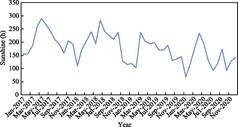 |
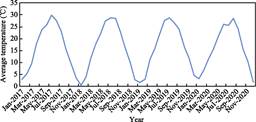 |
Soil Physicochemical Analysis
The majority of the soil in the area has formed on loess alluvial layers (Figures 6 and 7). The soil is sandy, with good air circulation and deep layers, with a thickness exceeding 5 m in most areas, and in some parts, the soil depth surpasses 20 m. The soil predominantly consists of fertile loess rich in organic matter, far exceeding the standard soil environmental criteria. In the case study area, multiple sampling points were established for collecting and monitoring soil samples from the burdock growing environment (Figure 8). These samples were analyzed by the Physical and Chemical Analysis Center of the Institute of Geographic Sciences and Natural Resources Research, Chinese Academy of Sciences, focusing on soil heavy metal content among other indices. Of the 25 soil samples tested, they were found to be rich in essential trace elements for human health, such as Ca, Mg, Fe, Mn, Zn, etc. (Table 3).
Analysis of the Current State of Water Resources in the Case Study Area
Geographically situated at the core of the Huaihai economic zone and on the southeastern edge of the North China Plain, the case study area benefits from natural water supplies formed by seasonal precipitation and snowmelt, providing ample moisture for the cultivation of burdock. Feng county has a total water resource volume of 546 million m3, including 126 million m3 of surface water and 327 million m3 of groundwater, with an additional inflow of 93 million m3 from external sources. The county features two water diversion routes: the south route diverts water from the Yangtze River with a transfer capacity of 26 m3/s, and the north route draws water from Weishan Lake with a capacity of 17 m3/s, providing over 200 million m3 of water annually to meet the industrial and agricultural water demands of Feng county as well as to replenish the groundwater. Within its territory, there is a secondary river reservoir in Dashaha with a storage capacity of 30 million m3 and the Miaocheng River reservoir with a capacity of 5 million m3, both of which can undergo multiple water transfers and storage operations as required. Additionally, the region is home to the Liangzhai Reservoir and an intricate network of 360 rivers with various sizes (Figure 9).
Table 3 Analysis results of selected soil metal elements from the burdock planting demonstration Garden in Feng county, Jiangsu province of China (mg/kg)
| Soil | 0–20 cm | 20–40 cm | 40–60 cm | 60–80 cm | 80–100 cm | Soil | 0–20 cm | 20–40 cm | 40–60 cm | 60–80 cm | 80–100 cm |
|---|---|---|---|---|---|---|---|---|---|---|---|
| Al | 63,266.44 | 63,266.44 | 52,511.02 | 46,401.82 | 5,3953.92 | Mn | 560.95 | 560.95 | 465.32 | 438.01 | 474.53 |
| Ba | 503.11 | 503.11 | 425.89 | 390.24 | 458.89 | Mo | 0.46 | 0.46 | 1.38 | 0.41 | 1.84 |
| Ca | 40,694.71 | 40,694.71 | 37,582.83 | 36,201.25 | 39,880.54 | Na | 14,965.10 | 14,965.10 | 13,419.63 | 12,727.71 | 15,026.85 |
| Ca | 41,682.79 | 41,682.79 | 38,378.59 | 36,413.91 | 40,898.43 | Ni | 31.66 | 31.66 | 28.12 | 23.44 | 31.18 |
| Cd | 0.02 | 0.02 | 0.03 | 0.01 | 0.02 | P | 1,375.42 | 1,375.42 | 529.21 | 538.07 | 587.22 |
| Co | 12.74 | 12.74 | 10.51 | 10.04 | 11.01 | P | 1,218.38 | 1,218.38 | 527.33 | 525.80 | 580.77 |
| Cr | 72.09 | 72.09 | 52.91 | 43.31 | 58.33 | Pb | 35.80 | 35.80 | 18.24 | 21.67 | 22.84 |
| Cu | 19.42 | 19.42 | 16.85 | 13.87 | 17.40 | S | 65.05 | 65.05 | 29.48 | 49.05 | 54.91 |
| Fe | 27,076.67 | 27,076.67 | 22,568.57 | 21,457.00 | 22,799.10 | Sc | 10.92 | 10.92 | 8.95 | 8.53 | 9.28 |
| K | 17,900.84 | 17,900.84 | 16,716.59 | 16,058.06 | 18,162.77 | Sr | 209.03 | 209.03 | 186.29 | 174.79 | 204.04 |
| La | 35.35 | 35.35 | 27.55 | 27.16 | 30.21 | Ti | 3,801.13 | 3,801.13 | 3,154.41 | 3,101.34 | 3,276.24 |
| Li | 28.49 | 28.49 | 25.54 | 24.45 | 26.43 | V | 69.96 | 69.96 | 59.86 | 57.93 | 62.48 |
| Mg | 4,147.13 | 4,147.13 | 3,593.05 | 3,443.30 | 3,751.63 | Zn | 65.36 | 65.36 | 37.70 | 34.82 | 38.08 |
The case study location is strategically positioned at the core of the Huaihai economic zone and the southeastern fringe of the North China Plain. It boasts a natural water supply derived from seasonal precipitation and melting snow, ensuring an abundant provision of water for burdock cultivation. The land here predominantly consists of fertile loess rich in organic matter, while the quality of the water supply significantly exceeds the standards for rural domestic use (Tables 4 and 5).
Table 4 Statistics of surface water pH in the case area of Feng county, Jiangsu province of China
| Water-ID | Location and description of sampling site | RID | pH |
|---|---|---|---|
| Surface Water-1 | Dashahedian Wetland (where the Dasha River enters Fengxian from Anhui) | 1A | 7.867 |
| Surface Water-1 | Dashahedian Wetland (where the Dasha River enters Fengxian from Anhui) | 1B | 7.865 |
| Surface Water-2 | Zhengji Southern Branch River (north of Yuanzihu Lake) | 2A | 6.99 |
| Surface Water-2 | Zhengji Southern Branch River (north of Yuanzihu Lake) | 2B | 7.056 |
| Surface Water-3 | Old Yellow River Course | 3A | 8.489 |
| Surface Water-3 | Old Yellow River Course | 3B | 8.473 |
| Surface Water-4 | Old Yellow River Course (southern end) | 4A | 8.184 |
| Surface Water-4 | Old Yellow River Course (southern end) | 4B | 8.172 |
| Surface Water-5 | Zhengji Southern Branch River (north of Gengzhuang village) | 5A | 7.37 |
| Surface Water-5 | Zhengji Southern Branch River (north of Gengzhuang village) | 5B | 7.409 |
| Surface Water-6 | Zhengji Northern Branch River (northwest of Yangwa village) | 6A | 7.109 |
| Surface Water-6 | Zhengji Northern Branch River (northwest of Yangwa village) | 6B | 7.136 |
| Surface Water-7 | West side of the Burdock Demonstration Garden | 7A | 7.776 |
| Surface Water-7 | West side of the Burdock Demonstration Garden | 7B | 7.733 |
| pH Average | 7.69 |
Table 5 Statistics of the groundwater pH in the case area of Feng County, Jiangsu province of China
| Water-ID | Location and description of sampling site | RID | pH |
|---|---|---|---|
| Ground Water-1 | Burdock Germplasm Base Well | 1A | 6.962 |
| Ground Water-2 | Burdock Germplasm Base Well | 1B | 6.981 |
| pH Average | 6.971,5 |
Product Characteristic Data
Burdock is a biennial herbaceous plant belonging to the genus Arctium of the Asteraceae family (Figure 10), with its above-ground and underground parts each capable of exceeding 1.5 m in length (Figure 11). It serves both as a food ingredient and a medicinal resource. The root contains components such as inulin, volatile oils, and polyphenols, and is also rich in fiber and amino acids, earning it the title of “gem of vegetables”[6]. Feng county leverages its dual value for medicinal and culinary uses to innovate and develop over 80 products such as burdock tea, burdock beverages, and a range of burdock food products[7] specialty burdock dishes like Osmanthus burdock are also widely popular.
The burdock from Feng county possesses the following product characteristics:
(1) Morphological features: Burdock is a biennial plant, typically with large leaves and a long, sturdy root. The leaves are heart-shaped or ovate, while the root is long and fleshy, usually brown or black in color.
(2) Edible parts: The edible parts of burdock primarily include the root and tender leaves. The root is commonly used in food preparation, and the young leaves can be consumed as a vegetable.
(3) Nutritional value: Burdock root is rich in nutrients, including dietary fiber, vitamins (such as vitamin B6 and vitamin C), and minerals (such as potassium, zinc, and manganese). Additionally, it contains various antioxidants, like polyphenolic compounds (Table 6).
(4) Food products: The root of burdock is often used to make a variety of foods, including stews, salads, soups, and pickles. In Japan, burdock is used to create the renowned dish 'burdock hot pot’. Moreover, burdock recipes offered in restaurants are quite popular, for instance, shredded burdock, Tosa-style burdock, burdock with plums, burdock avocado salad, smashed burdock, burdock mixed with nuts, burdock salad, burdock beef rolls, etc. The dataset lists detailed ingredients and preparation methods for 15 types of burdock dishes introduced by Japanese restaurants.
| Figure 10 Burdock flowering and seeding in its second year | Figure 11 The above-ground and underground parts of burdock can each reach over 1.5 m in length |
|---|---|
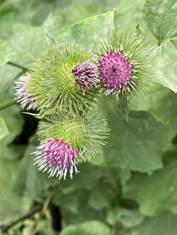 |
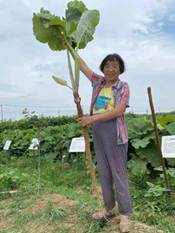 |
Table 6 Chemical element analysis of burdock root from Feng county, Jiangsu province of China (mg/kg)
| Sample name | Burdock root-1 | Burdock root-2 | Burdock root-3 | Burdock stem (with skin)-1 | Burdock stem (with skin)-2 | Burdock stem (pith) |
|---|---|---|---|---|---|---|
| Quality | 0.12 g | 0.12 g | 0.15 g | 0.12 g | 0.12 g | 0.12 g |
| Volumetric Standardization | 10 mL | 10 mL | 10 mL | 10 mL | 10 mL | 10 mL |
| Al 396.153 | 95.50 | 77.43 | 35.44 | 48.54 | 48.58 | 414.08 |
| Ba 233.527 | 3.07 | 2.38 | 1.41 | 7.73 | 8.43 | 13.61 |
| Ca 317.933 | 3,096.67 | 2,411.67 | 1,582.67 | 11,875.00 | 13,241.67 | 15,333.33 |
| Cd 228.802 | 0.00 | 0.00 | 0.00 | 0.03 | 0.04 | 0.00 |
| Co 228.616 | 0.15 | 0.18 | 0.11 | 0.09 | 0.03 | 0.36 |
| Cr 205.560 | 10.73 | 8.44 | 3.77 | 2.91 | 3.23 | 18.76 |
| Cr 267.716 | 10.73 | 8.33 | 3.73 | 2.70 | 3.08 | 18.72 |
| Cu 327.393 | 8.38 | 6.72 | 4.03 | 2.93 | 3.09 | 5.14 |
| Fe 238.204 | 124.58 | 100.42 | 51.26 | 60.34 | 62.26 | 436.92 |
| K 766.490 | 23,233.33 | 18,625.00 | 9,253.33 | 19,741.67 | 20,591.67 | 19,975.00 |
| Li 670.784 | 0.68 | 0.47 | 0.45 | 0.68 | 0.54 | 1.21 |
| Mg 285.213 | 2,568.33 | 2,034.17 | 1,324.00 | 3,577.50 | 3,889.17 | 4,382.50 |
| Mn 257.610 | 8.65 | 7.50 | 4.44 | 7.19 | 7.77 | 14.33 |
| Mo 202.031 | 1.02 | 0.98 | 0.80 | 0.89 | 0.86 | 2.11 |
| Na 589.592 | 2,840.00 | 2,496.67 | 2,130.00 | 652.67 | 742.67 | 1,089.17 |
| Ni 231.604 | 3.90 | 3.14 | 1.81 | 1.32 | 1.54 | 6.32 |
| P 213.617 | 2,494.17 | 2,224.17 | 1,730.00 | 1,515.00 | 1,654.17 | 1,955.83 |
| P 214.914 | 2,509.17 | 2,245.00 | 1,728.67 | 1,449.17 | 1,604.17 | 1,956.67 |
| Pb 220.353 | 0.25 | 0.26 | 0.10 | 0.32 | 0.28 | 0.48 |
| S | 888.33 | 920.83 | 857.33 | 3,088.33 | 3,510.00 | 3,628.33 |
| Sr 407.771 | 43.14 | 33.72 | 21.65 | 69.12 | 77.42 | 88.67 |
| Ti 334.940 | 9.68 | 9.36 | 4.93 | 10.43 | 9.53 | 27.29 |
| Ti 336.121 | 9.61 | 9.37 | 4.63 | 10.27 | 9.37 | 27.06 |
| V 290.880 | 0.00 | 0.00 | 0.00 | 0.00 | 0.00 | 0.00 |
| V 310.230 | 0.96 | 0.77 | 0.25 | 0.34 | 0.26 | 0.99 |
| Zn 206.200 | 7.74 | 7.22 | 4.13 | 7.59 | 6.99 | 9.88 |
(5) Herbal uses: The root of burdock also has herbal applications and is believed to have
health benefits. Traditionally, it has been used to support kidney and urinary system health, as well as to combat inflammation and bronchitis.
(6) Market products: In the market, one can find various forms of burdock products, including fresh roots, sliced, tea bags, root powder, herbal extracts, and nutritional supplements. These products may be used in food production, health products, or herbal medicine.
(7) Quality standards: For food and health products, burdock products typically need to meet local quality standards and regulations. These standards include food safety, quality control, and labeling requirements.
In summary, burdock is a versatile plant with roots and leaves that offer rich nutritional value and herbal uses[8]. Burdock products can be found in different markets and are widely utilized across various cultures.
Through the analysis of the nutritional components of burdock, characteristic active factors of burdock have been identified, and the patterns of activity change during its processing have been established. The difference between essential amino acids and total amino acids is not significant. The arginine content is the highest in Feng county burdock powder, while the glutamic acid content is the highest in Peixian burdock powder (Table 7).
Burdock root has the highest content of potassium, followed by calcium, phosphorus, magnesium, and sodium (Table 8). Burdock contains a large number of macroelements and trace elements that are essential for the human body, making it an excellent mineral supplement. The content of harmful elements and carcinogens in burdock is below the national standards, indicating that burdock is a safe food[9].
Table 7 Amino acid content in burdock root powder (mg/g)
| Sample | Feng county | Pei county | Sample | Feng county | Pei county | Sample | Feng county | Pei county |
|---|---|---|---|---|---|---|---|---|
| Aspartic Acid | 11.06 | 13.01 | Cysteine | 1.04 | 1.46 | Essential Amino Acids | 16.151 | 16.062 |
| Glutamic Acid | 18.29 | 17.66 | Proline | 6.42 | 5.65 | Non-Essential Amino Acids | 67.478 | 64.390 |
| Serine | 3.38 | 3.17 | Valine | 2.28 | 2.37 | Pharmacologically Active Amino Acids | 62.710 | 60.566 |
| Histidine | 0.81 | 0.85 | Phenylalanine | 4.37 | 4.51 | Sweet Amino Acids | 19.156 | 17.302 |
| Glycine | 2.66 | 2.37 | Isoleucine | 2.00 | 2.15 | Umami (Savory) Amino Acids | 29.351 | 30.670 |
| Arginine | 19.70 | 16.53 | Leucine | 2.78 | 2.88 | Bitter Amino Acids | 31.936 | 29.286 |
| Alanine | 1.98 | 1.97 | Lysine | 1.85 | 1.46 | Total Amino Acid Content | 80.761 | 77.762 |
| Tyrosine | 2.15 | 1.74 | Threonine | 2.87 | 2.69 |
Table 8 Inorganic elements in burdock root (µg/g)
| Element | Sample element content | Element | Sample element content | Element | Sample element content | Element | Sample element content |
|---|---|---|---|---|---|---|---|
| K | 108,97.38 | P | 3,176.83 | Zn | 16.73 | Co | <0.50 |
| Ca | 4,205.58 | Cr | 20.45 | Al | 192.48 | Pb | <0.50 |
| Mg | 2,424.318 | Cu | 13.23 | Ti | 4.59 | V | <0.50 |
| Na | 751.57 | Mn | 4.82 | Be | <0.50 | Sb | <0.50 |
| Fe | 58.49 | Ni | <0.50 | Ba | 2.90 | Cd | <0.50 |
Management
Burdock Cultivation Management
Feng county has established a dedicated Burdock Production Management Leadership Team to uniformly organize and implement planting management, ensuring standardized production of burdock cultivation. The management technical standards include planting, irrigation, fertilization, pest control, procurement, and storage, among other aspects. The main technical and management measures and standards for Feng county burdock are as follows:
Land Preparation and Fertilization
For every 667 m2, apply 5,000 kg of matured farmyard manure, 40–50 kg of nitrogen fertilizer, 30 kg of calcium superphosphate, and 30 kg of potassium sulfate. Mix and concentrate these in furrows and then proceed with land preparation. Prior to sowing, deep plow the planting strips to more than 80 cm, achieving depth, fineness, permeability, evenness, and levelness, and remove stones, tile fragments, and other hard objects to reduce the occurrence of forked and grafted roots.
Seed Treatment and Sowing
(1) Seed Treatment
Before sowing, disinfect and pre-germinate the seeds. Soak the seeds in 55 ℃ warm water for 10 minutes or mix with 0.3% of the seed weight of Thiram fungicide, then rinse with clean water. After that, soak them in 40–50 ℃ warm water for 8 hours, wrap in a damp cloth, and place at 25–30 ℃ for germination for about 30 hours until the seeds show white sprouts before sowing.
(2) Sowing
Burdock is generally directly sown without nursery transplanting; it can be sown in rows, broadcast, or hole-sown, with row sowing being the most effective. Reasonable close planting will yield quality fleshy roots (Figure 12).
a. Row sowing. Open a 3 cm deep trench in the middle of the ridge, water adequately, after the water seeps away, place one seed at an 8–10 cm plant spacing, cover with 3 cm of soil, and then lay a plastic film. The sowing amount per 667 m2 is about 200 g.
b. Broadcast sowing. Open a 3 cm deep shallow trench in the middle of the ridge, water lightly, after the water seeps away, broadcast seeds at a 5 cm plant spacing, cover with 2 cm of soil, with a sowing amount per 667 m2 being about 250 g.
c. Hole sowing. Dig holes at a plant spacing of 7–10 cm, sowing 3–4 seeds per hole, with a seeding amount of about 500 g per 667 m2. If sowing ungerminated seeds, sow at a 10 cm hole spacing, with 4–5 seeds per hole.
Field Management
(1) Film breaking and thinning
a. Film breaking. For pre-germinated seeds, sow in early to mid-March, and break the film to open holes and guide the seedlings 10–15 days after emergence. For seeds sown at the beginning of April, seedlings emerge after about 7 days.
b. Thinning. When the seedlings grow to 2–3 leaves, thin them to a spacing of 5–8 cm, or keep 2 plants per hole; when the seedlings grow to 5 leaves, thin them to a spacing of 7–10 cm, or keep 1 plant per hole.
(2) Cultivation, weeding, and soil hilling
Burdock seedlings grow slowly and there tend to be many weeds during the seedling stage, thus timely inter-row cultivation and weeding are necessary. From the stage of having 2–3 leaves until the ridges are closed, inter-row cultivation should be carried out 2–3 times. In addition to eliminating weeds, early cultivation also loosens the soil, raises the soil temperature, and promotes root development and seedling growth. The final cultivation and weeding before hilling should add soil to the root area to facilitate the straight growth and expansion of the root. After hilling, any emerging weeds should be promptly removed.
(3) Water and fertilization management
a. Top dressing. Three top dressings are usually needed. The first is after the seedlings are established, applying 1,000 kg of mature human excrement per 667 m2 or applying 15 kg of urea in a trench made in the middle of the ridge. The second is during the vigorous growth phase of the plant, which for spring-sown plants is in late May to early June, and for autumn-sown plants around late September, applying 1,000–1,500 kg of mature human excrement, or combined with watering, applying 1,000 kg of mature human excrement or 10–15 kg of urea per 667 m2, spreading it in the furrows to promote root and leaf growth. The third is when the fleshy roots start to expand, which for spring-sown plants is around early to mid-July, and for autumn-sown plants before the freeze, applying 1,500 kg of human excrement per 667 m2, or 20 kg of NPK fertilizer, to promote rapid root growth. The top dressing method involves trenching 10–15 cm from the plant and applying it, avoiding root burn and the formation of forked roots.
b. Watering. After 3–4 leaves, water is controlled during the seedling stage. After the seedling stage, the plant enters a vigorous growth phase, the fleshy roots rapidly expand, and the water requirement increases; water early in the day if necessary, keeping the soil moist but not overwatering. During the rainy season, timely drainage should be conducted to prevent ridge settling, causing malformed roots, or even root rot.
Autumn-sown burdock should be watered once before freezing, and as the temperature drops, covered with pig manure or chopped straw, or hilled with soil for cold protection to ensure safe overwintering.
Causes of Malformed Roots and Main Preventive Measures
(1) Clay soils with large clods tend to cause forked roots. Therefore, deep, sandy soil or sandy loam should be chosen for cultivating burdock.
(2) The use of uncomposted manure can cause the tip of the main root to split. Thus, organic fertilizers should be fully composted and applied on one side of the plant, covered with soil, and not in direct contact with the main root.
(3) Excessive use of chemical fertilizers can lead to high soil solution concentration, causing root splitting, so the amount of chemical fertilizer applied should be appropriate.
(4) During the seedling stage and the initial development of the main root, if the soil is too dry, this can also lead to splitting. Therefore, water should be applied timely to keep the soil moist and loose; after the plant has grown three leaves, it has a stronger drought resistance and does not require frequent watering unless in severe drought; avoid standing water in the field which can induce malformed roots.
(5) Using new seeds with high germination vigor can also prevent the occurrence of forked roots.
Harvesting
Harvest in batches according to the growth of the fleshy root and the requirements of the processing enterprise. Generally, 100–130 days after sowing is the suitable harvest period. Spring-sown burdock can be harvested from September to March of the following year, and with early spring film covering cultivation, the harvest can be advanced to August. Autumn-sown burdock starts harvesting from April to May of the following year. Harvest when the fleshy root thickens to 3–4 cm; harvesting too early results in thin roots and low yield, while harvesting too late can lead to hollow roots.
During harvesting, first use a sharp knife to cut the leaves 10 cm above the ground surface, leaving 15–20 cm of the leaf stem, then dig a trench 70–80 cm deep and 25–35 cm wide on the side of the plant, loosen the soil, hold the base of the plant and gently pull it out at a 75° angle, taking care to avoid breaking or damaging the roots. If the soil is too hard, water thoroughly once before harvesting. After harvesting, the fleshy roots should be cleared of fine roots and dirt, trimmed at 2 cm from where the leaf stalks remain, and washed clean with water. The harvested roots should be graded according to purchasing standards, ensuring that they are long, straight, and intact, without disease or insect marks, mechanical damage, mold, or hollow cores.
Burdock Harvesting and Processing Technology Management
Raw Material Selection
Select burdock roots that are free from forking, pest infestation, and disease to be used as raw materials for processing fresh burdock.
Cleaning and Packaging
First, place the burdock in a cement pool and use clean water to wash off the surface soil. Then, use a fine steel wire ball to remove the skin and rootlets. After another rinse with clean water, the burdock is ready to be packaged. Grade A products use small packaging. The small packaging is a silicone fresh-keeping plastic bag with a length of 100 cm and a width of 8.5 cm (one burdock root in a bag). Grade B products use larger packaging, typically a cardboard box weighed to 10 kg per box (80 cm ×25 cm×15 cm). Finally, the product is sealed with plastic tape and ready for storage.
Storage
When the packaged fresh burdock is transported to the cold storage for constant temperature storage, the temperature should be controlled at –1 ℃ to 1 ℃. Under these conditions, it can generally be stored for 5–6 months.
Feng County Burdock Traceability Technology
Feng county has conducted scientific and systematic technical research and development on the quality of Feng county burdock from multiple perspectives, including the climate characteristics of the burdock producing area, meteorological conditions during the burdock growth period, and burdock quality testing (Figure 13). This includes technologies such as dietary fiber separation and enrichment, preparation of porous adsorbent materials for sugars and lipids, burdock polyphenol nano-coating for preservation, inhibition of starch aging and regeneration by burdock CNCs (Cellulose NanoCrystals), reduction of glycemic response in high-starch foods by burdock CNCs, preparation of high satiety dietary fibers, combined ultrasonic and low-alcohol induction technology for autonomous assembly of burdock glycoproteins, precision combination technology for regulating sugar and lipid metabolism, and nanoscale preparation technology for dietary fibers with glucosidase inhibition efficacy.
Promotion and Brand Management for Feng County Burdock
Promotion and Brand Creation
In recent years, Feng county has continuously intensified its efforts to promote the “Burdock” brand, further increasing public awareness of the advantages of burdock and stimulating consumer interest. Making full use of the “Hometown of Burdock” as a leading label, relying on existing enterprises, Feng county has built a burdock town that integrates industry development and has actively applied to be recognized as a national-level agricultural industry stronghold. It endeavors to create a pattern where “For global burdock, look to China; for Chinese burdock, look to Feng county”.
Today, Feng county has successfully established a “Burdock” brand cultural promotion platform, hosting significant events such as the International Burdock Health Culture Festival and the Burdock Health Industry Symposium. It has positioned the development of the burdock health industry as a key project to attract investments, bringing in related enterprises to invest in deep-processing projects in Feng county, promoting the integrated development of science, industry, and trade, and laying a solid foundation for the brand development of “Burdock”. In terms of deep processing, Feng county has delved into the added value of burdock products, extending the burdock industry chain. Consequently, it has launched a series of “Feng County Burdock” products, including burdock tea, burdock enzymes, burdock sauce, burdock beverages, burdock liquor, and burdock food items. These initiatives have significantly contributed to the diversification and enhancement of the burdock industry in the region.
Brand Development of Burdock Products
The Feng county People’s Government places high importance on the branding of burdock products. Initially, it focuses on implementing work responsibilities and extended trademark services to the grassroots level, enhancing business training for grassroots trademark supervision personnel, establishing comprehensive trademark archives, and grassroots contact point systems. Simultaneously, by fully utilizing large-scale exhibitions such as the China Trademark Festival and Agricultural Products Trade Fairs, the county organizes well-known trademark enterprises to participate, actively expanding the regional brand’s popularity and influence, and guiding local burdock enterprises towards a path of brand development. In-depth enterprise visits for guidance services, daily business consultations, centralized promotion on activity days, and conducting trademark registration legal consultation activities are carried out to guide burdock enterprises in brand protection and use, strengthening brand construction. Through media promotion, the county vigorously disseminates knowledge of the new “Trademark Law” and brand protection and utilization to all sectors of society.
Feng county, known as the “Hometown of Burdock”, hosted the China (Feng county) Burdock Industry International Summit Forum. Experts from domestic regions and countries like Ireland, Japan, and France participated in on-site inspections to promote the upgrading and quality improvement of burdock products. A Burdock Industry Research Institute was established, and a specialized committee for the burdock industry was formed within the Science and Technology Innovation Alliance of the Food-Medicine Homologous Industry. Collaborative mechanisms have also been established with institutions like the Chinese Academy of Agricultural Sciences, provincial agricultural science academies, and other universities and research institutes.
Discussion and Conclusion
Standardized Management
Fengxian burdock adopts standardized planting methods[10]. Planting technology is large-scale, mechanized, scientific, and burdock product varieties are diversified, popular, and modern[11–13], taking the lead in realizing the full mechanization of burdock production in the country, and establishing HACCP food safety traceability control management system, which ensures the quality and quality of burdock products.
Protecting the Intellectual Property Rights of GIES
Feng county has formulated and issued a development plan for fostering brand growth within industry clusters, providing significant policy support for the implementation of a trademark strategy. This has created a strategic development mechanism led by the government, with interdepartmental collaboration, market supervision assistance, and enterprise initiative. A number of brand clusters have been constructed around advantageous and strategic emerging industries. The county government has successively introduced a series of policies to accelerate the development of the service industry, further promote transformation and upgrading for rapid new industrialization, and support industrial development to strengthen the real economy. The issuance of these documents has further implemented related incentive measures and department responsibilities, establishing a brand-creation work mechanism of “government guidance, department support, enterprise operation, and public participation”. Continued research, combined with policies, is needed for future land protection and sustainable development of the agricultural ecosystem.
The ‘ Company + Base + Farmer + Market’ Model
Since 2016, when burdock root was classified as a common food material by the National Health and Health Commission, the burdock industry has entered a phase of rapid development. For many years, apart from specialized agricultural product stores, burdock processed products have been absent from mainstream sales channels represented by supermarkets. Today, this “shackle” has finally been broken. Burdock enterprises, large and small, have shaken off their constraints and are re-engaging in business, restarting industry expansion plans that have been stalled for years, and bringing good opportunities for farmers to escape poverty and become wealthy. Feng county has built a thousand-acre burdock demonstration garden and established professional burdock cooperatives, creating a one-stop industrialized business pattern from production to sales, leading villagers to increase their income and wealth. The local adoption of the “company + base + farmers + market” model has established burdock product processing factories, provided more employment opportunities, and driven local farmers to collectively prosper.
References
[1] Wei. C. J. Practice and thoughts on the development of the burdock industry chain [J]. Chinese Vegetables, 2012(23): 13–16.
[2] Li, Z. M., Li, X. Z., Chang, Y., et al. The effect of different soil factors on the quality of traditional Chinese medicine burdock seeds [J]. Soil Bulletin, 2011, 42(1): 106–111.
[3] Liu, C., Gong, K., Liu, Y. H., et al. A new mechanism to solve the “Lucid waters and lush mountains are invaluable assets”―the ten-year action plan for “High-quality geographical product habitat protection and sustainable development” multi-party cooperation officially launched [J]. Journal of Global Change Data & Discovery, 2021, 5(3): 11–22. https://doi.org/10.3974/geodp.2021.03.03.
[4] Yao, F. T., Chang, J. B., Zhao, C. Y., et al. Fengxian burdock (Arctium lappa) ancient Yellow River flooding area case dataset on habitat protection and sustainable development [J/DB/OL]. Digital Journal of Global Change Data Repository, 2021. https://doi.org/10.3974/geodb.2021.06.06.V1.
[5] GCdataPR Editorial Office. GCdataPR data sharing policy [OL]. https://doi.org/10.3974/dp.policy.2014.05 (Updated 2017).
[6] Zhang, X., X., Chai, Z., Feng, J., et al. Advances in the extraction and biological activity of burdock polysaccharides [J]. Food and Fermentation Industries, 2021, 47(6): 280–288.
[7] Cui, L., Pan, X., Zhang, X, X., et al. Research on the screening and optimization of heat-resistant burdock composite protectants for probiotics [J]. Jiangsu Agricultural Science, 2020, 48(18): 211–214.
[8] Liang, W., Li, Y., Feng, J., et al. Research progress on burdock root and its deep processing [J]. China Food Journal, 2022, 22(2): 413–420.
[9] Cui, L., Li, Y., Feng, J., et al. The effect of heat shock combined with burdock heat protectant on the spray drying activity of probiotics in probiotic milk powder [J]. Jiangsu Agricultural Science, 2021, 49(10): 166–169.
[10] Xuzhou Market Authority. Geographical indication certification trademark: Fengxian burdock [S]. Xuzhou Local Standard, 2023-10-28.
[11] Shi, H. H. Development status and countermeasures of burdock industry in Fengxian county [J]. Extension of Agricultural Technology, 2023, 11: 100–102.
[12] Shi, H. H., Cui, J. Q., Lu, H. M. Research on the development of burdock industry in Fengxian county [J]. Industrial Economy, 2023(11): 1–3.
[13] Yao, F. T., Liu, F. H., Xing, H. Current situation and countermeasures of industrial chain development of burdock in Fengxian county [J]. Agriculture and Technology, 2020, 40(18): 166–168.
Case Team
Principle Investigator
Principle Investigator Yao Fengteng
Yao Fengteng, has served as the Deputy Director of the Retirement Management Center of Jiangsu Academy of Agricultural Sciences, Deputy Director and Associate Professor of the Liuhe Animal Science Base of Jiangsu Academy of Agricultural Sciences, Deputy Director of the Lishui Occupational Science Base of Jiangsu Academy of Agricultural Sciences, and Deputy County Mayor of Feng County People's Government. Now he is Deputy Director of Yafu Science and Technology Service Station at the Achievement Transformation Department of Jiangsu Academy of Agricultural Sciences.
Expert members of the case team
Chang Jiabing, Rural Affair and Agriculture Bureau of Fengxian County, Xuzhou, Jiangsu Province
Zhao Chengyi, Rural Affair and Agriculture Bureau of Fengxian County, Xuzhou, Jiangsu Province
Hu Chuanyin, Burdock Breeding Base in Fengxian County, Xuzhou, Jiangsu Province
Wang Zhenbo, Institute of Geographic Sciences and Natural Resources Research, Chinese Academy of Sciences
Wang Zhengxing , Institute of Geographic Sciences and Natural Resources Research, Chinese Academy of Sciences
Li Kexin, Institute of Geographic Sciences and Natural Resources Research, Chinese Academy of Sciences
Yu Bohua, Institute of Geographic Sciences and Natural Resources Research, Chinese Academy of Sciences
Chen Wenbo, Nature & Science Consulting Co. Ltd., Yokohama, Japan
Doko Tomoko, Nature & Science Consulting Co. Ltd., Yokohama, Japan
Liu Chuang, Institute of Geographic Sciences and Natural Resources Research, Chinese Academy of Sciences
Author Contributions
Yao, F. Y., Wang, Z. B., and Liu, C. conducted the overall design for the development of the Feng county burdock case in the ancient Yellow River flood area and its dataset; Liu, C., Yu, B. H., Li, K. X., Chang, J. B., and Zhao, C. Y. collected and processed the data; Chen, W. B. and Doko, T. provided data on Japanese burdock recipes; Hu, C. Y., Su, N. and Gu, H. Y. wrote the data paper, with Liu, C. ultimately reviewing the data and the paper.
Acknowledgements
We express our gratitude to Gong, K., former President of the World Federation of Engineering Organizations (WFEO), and He, C. C., former Deputy Director-General of the Food and Agriculture Organization of the United Nations (FAO), for their support and guidance on the Feng county burdock ancient Yellow River Flood Area case study. We also thank Lu, F., the Mayor of Feng County People’s Government, for his personal involvement and special contributions in facilitating and coordinating multiple collaborations.
